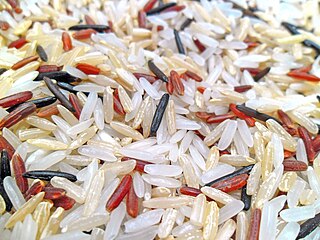
Rice is the seed of the grass species Oryza sativa or less commonly Oryza glaberrima. The name wild rice is usually used for species of the genera Zizania and Porteresia, both wild and domesticated, although the term may also be used for primitive or uncultivated varieties of Oryza.

Millets are a highly varied group of small-seeded grasses, widely grown around the world as cereal crops or grains for fodder and human food. Most species generally referred to as millets belong to the tribe Paniceae, but some millets also belong to various other taxa.

Eleusine coracana, or finger millet, also known as ragi in India, kodo in Nepal, is an annual herbaceous plant widely grown as a cereal crop in the arid and semiarid areas in Africa and Asia. It is a tetraploid and self-pollinating species probably evolved from its wild relative Eleusine africana.

Crop rotation is the practice of growing a series of different types of crops in the same area across a sequence of growing seasons. It reduces reliance on one set of nutrients, pest and weed pressure, and the probability of developing resistant pests and weeds.

New Rice for Africa ("NERICA") is a cultivar group of interspecific hybrid rice developed by the Africa Rice Center (AfricaRice) to improve the yield of African rice cultivars. Although 240 million people in West Africa rely on rice as the primary source of food energy and protein in their diet, the majority of this rice is imported. Self-sufficiency in rice production would improve food security and aid economic development in West Africa.

Agroforestry is a land use management system in which trees or shrubs are grown around or among crops or pastureland. Trees produce a wide range of useful and marketable products from fruits/nuts, medicines, wood products, etc. This intentional combination of agriculture and forestry has multiple benefits, such as greatly enhanced yields from staple food crops, enhanced farmer livelihoods from income generation, increased biodiversity, improved soil structure and health, reduced erosion, and carbon sequestration. Agroforestry practices are highly beneficial in the tropics, especially in subsistence smallholdings in sub-Saharan Africa and have been found to be beneficial in Europe and the United States.
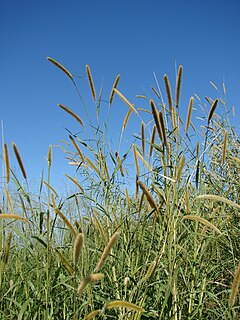
Cenchrus purpureus, synonym Pennisetum purpureum, also known as Napier grass, elephant grass or Uganda grass, is a species of perennial tropical grass native to the African grasslands. It has low water and nutrient requirements, and therefore can make use of otherwise uncultivated lands.

Echinochloa is a very widespread genus of plants in the grass family and tribe Paniceae. Some of the species are known by the common names barnyard grass or cockspur grass.
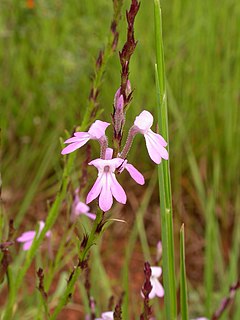
Striga, commonly known as witchweed, is a genus of parasitic plants that occur naturally in parts of Africa, Asia, and Australia. It is in the family Orobanchaceae. Some species are serious pathogens of cereal crops, with the greatest effects being in savanna agriculture in Africa. It also causes considerable crop losses in other regions, including other tropical and subtropical crops in its native range and in the Americas.
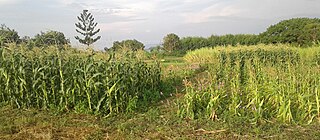
Push–pull technology is an intercropping strategy for controlling agricultural pests by using repellent "push" plants and trap "pull" plants. For example, cereal crops like maize or sorghum are often infested by stem borers. Grasses planted around the perimeter of the crop attract and trap the pests, whereas other plants, like Desmodium, planted between the rows of maize, repel the pests and control the parasitic plant Striga. Push–pull technology was developed at the International Centre of Insect Physiology and Ecology (ICIPE) in Kenya in collaboration with Rothamsted Research, UK. and national partners. This technology has been taught to smallholder farmers through collaborations with universities, NGOs and national research organizations.

Pendimethalin is an herbicide of the dinitroaniline class used in premergence and postemergence applications to control annual grasses and certain broadleaf weeds. It inhibits cell division and cell elongation. Pendimethalin is listed in the K1-group according to the Herbicide Resistance Action Committee (HRAC) classification and is approved in Europe, North America, South America, Africa, Asia and Oceania for different crops including cereals, corn, soybeans, rice, potato, legumes, fruits, vegetables, nuts as well as lawns and ornamental plants.
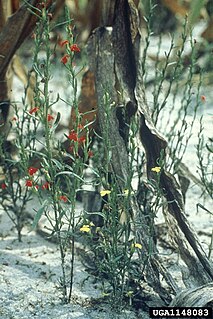
Striga asiatica, the Asiatic witchweed or the red witchweed, is a hemiparasitic plant in the family Orobanchaceae. It is native to Asia and sub-Saharan Africa, but has been introduced into other parts of the world including Australia and the United States. Asiatic witchweed is a serious agricultural pest, as it parasitises important crop species, including corn, rice, sorghum, and sugar cane, often causing substantial yield reductions.

Paspalum scrobiculatum, commonly called Kodo millet or Koda millet, is an annual grain that is grown primarily in Nepal and also in India, Philippines, Indonesia, Vietnam, Thailand, and in West Africa from where it originated. It is grown as a minor crop in most of these areas, with the exception of the Deccan plateau in India where it is grown as a major food source. It is a very hardy crop that is drought tolerant and can survive on marginal soils where other crops may not survive, and can supply 450–900 kg of grain per hectare. Kodo millet has large potential to provide nourishing food to subsistence farmers in Africa and elsewhere.
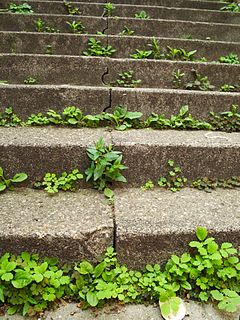
A weed is a plant considered undesirable in a particular situation, "a plant in the wrong place", or a plant growing where it is not wanted. This introduces the concept of human and their goal in any particular setting. The concept of weeds is particularly significant in agriculture, where the aim is growing crops or pastures of a single species, or a mixture of a few desired species. In such environments, other plant species are considered undesirable and therefore a weed. Besides, some weeds have undesirable characteristics making them a plant pest in most human settings.

Striga hermonthica, commonly known as purple witchweed or giant witchweed, is a hemiparasitic plant that belongs to the family Orobanchaceae. It is devastating to major crops such as sorghum and rice. In sub-Saharan Africa, apart from sorghum and rice, it also infests maize, pearl millet, and sugar cane.

Parthenium hysterophorus is a species of flowering plant in the family Asteraceae. It is native to the American tropics. Common names include Santa-Maria, Santa Maria feverfew, whitetop weed, and famine weed. In India, it is locally known as carrot grass, congress grass or Gajar Ghas. It is a common invasive species in India, Australia, and parts of Africa.
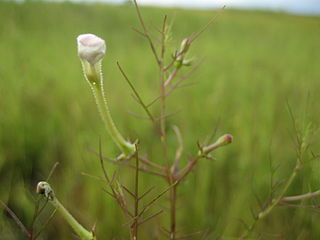
Rhamphicarpa fistulosa is a flowering plant species in the family Orobanchaceae - and the genus Rhamphicarpa. The plant is pale-green but can turn reddish towards maturity. It has needle-like leaves and white flowers with long corolla tubes. The flowers only open after sunset and are supposedly pollinated by night moths. The plant has a broad distribution in Africa and can also be found in New Guinea and northern Australia.

The effects of climate change on agriculture can result in lower crop yields and nutritional quality due to for example drought, heat waves and flooding as well as increases in pests and plant diseases. The effects are unevenly distributed across the world and are caused by changes in temperature, precipitation and atmospheric carbon dioxide levels due to global climate change. In 2019, millions already suffer from food insecurity due to climate change and predicted decline in global crop production of 2% - 6% by decade. It has been predicted in 2019 that food prices will rise by 80% by 2050 which will likely lead to food insecurity, disproportionally affecting poorer communities. A 2021 study estimates that the severity of heatwave and drought impacts on crop production tripled over the last 50 years in Europe – from losses of 2.2% during 1964–1990 to losses of 7.3% in 1991–2015.
Sorghum is an important staple crop for more than 500 million people in sub-Saharan Africa and South Asia, including many people in Nepal. In statistics collected from 1992-1994 about general millet, Nepal had an area of 0.21 million ha, with a yield rate of 1.14 (t/ha), and produced around 0.24 million tons of sorghum. The entirety of the crop is highly valued, with both the grain and the stem being utilized. The Terai region of Nepal tends to be more tropical which is ideal for the growth of sorghum. It tolerates hot climates better than maize or soybeans. For subsistence farmers, like those in Nepal, fertilizers are not necessary and the crop is frequently harvested by hand.

Jonathan Gressel is an Israeli agricultural scientist and Professor Emeritus at the Weizmann Institute of Science in Rehovot, Israel. Gressel is a "strong proponent of using modern genetic techniques to improve agriculture" especially in third world and developing countries such as Africa. In 2010, Gressel received Israel's highest civilian award, the Israel Prize, for his work in agriculture



















